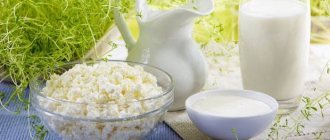Maltseva Oksana Alexandrovna
Nutritionist
The question of whether or not adults should drink milk has broken more than a dozen copies. Some talk about the incredible benefits of milk. After all, milk is life itself. Others say that milk and adults are incompatible things.
Who is right in this dispute?
But first, let's define the terminology.
Many people confuse it - they call lactase deficiency lactose deficiency. This is not true. There is no such term as lactose intolerance.
It's correct to say:
- Lactose intolerance
- Lactase deficiency
- lactose intolerance
- lactase deficiency
It's simple. A person lacks the enzyme lactase, so he is intolerant to lactose, a substance that this very enzyme breaks down.
Now let's get back to our milk.
Is milk and milk products normal food for an adult?
One of the main arguments of opponents of eating dairy products is the unnaturalness of this type of nutrition for humans.
And that's true. If you think about it, humans are the only living creatures on planet Earth that drink milk as adults, not only milk of their own species, but also that obtained from other mammals.
Milk is intended to quickly nurture newborn offspring. But an adult does not need rapid cultivation. So then why does he drink milk?
Before the agricultural revolution, people drank milk, but in the same way as all other mammals on the planet. That is, only breast milk from their mothers during infancy. In other words, the human species was formed in the complete absence of milk feeding in adulthood.
Everything is clear and logical.
However, scientific research shows that because people in many regions of the Earth have been eating dairy products for many thousands of years, their genes have changed. And now, even as adults, they are able to digest milk much more efficiently than their distant ancestors or those representatives of the human race who come from “non-dairy” regions.
How much milk do you need
The minimum daily human need for calcium - about 500 mg - can be obtained from half a liter of milk. Since the fat content of milk does not affect the mineral content, you can drink both whole and low-calorie
skim milk to obtain calcium.
How not to make mistakes when buying
Some dairy products may have too much sugar, salt or fat. We will teach you how to choose dairy products correctly.
The body also receives calcium from fermented milk products.
There is approximately the same amount of it in kefir, fermented baked milk and yogurt as in milk. And milk contains 0.15 mg of riboflavin - also known as vitamin B2 - per 100 g. A glass of milk from the product can meet the daily requirement
of an adult for this vitamin.
Conclusion
: drink at least a couple of glasses of milk or fermented milk products a day.
Why is milk and some dairy products so difficult for adults to digest?
The main carbohydrate in milk is lactose, or “milk sugar,” which is made up of two simple sugars—glucose and galactose.
In infancy, the human body produces the enzyme lactase, which successfully breaks down lactose in mother's milk. But as a person gets older, lactase production decreases, the ability to digest lactose decreases and may completely disappear.
It has now been established that 75% of the world's population is not able to digest lactose in adulthood, that is, they have lactose intolerance (lactase deficiency). Not everyone has severe intolerance. But to one degree or another it happens to many people.
It must be said that lactose intolerance has different distribution in different regions of our planet.
As can be seen from the data presented in the figure, our country, Europe, North America and Australia suffer from lactose intolerance much less than Asia, Africa and South America.
Symptoms of lactase deficiency in adults
Symptoms of lactose intolerance in adults range from severe to mild, depending on how much of the lactase enzyme the body is able to produce.
Symptoms of the disease begin to appear in the range from 30 to 120 minutes after dairy products enter the gastrointestinal tract.
Symptoms of lactase deficiency include:
- bloating
- pain (usually cramping) in the lower abdomen
- rumbling in the stomach and passing gas
- diarrhea (sometimes loose, foamy stools)
- nausea and vomiting.
Typically, symptoms of lactase deficiency increase with age. And as someone gets older, a person who calmly drank milk in his youth may lose the ability to even eat ice cream. This is a completely normal development of events. No worries.
Symptoms of lactase deficiency in infants
Lactase deficiency in infants is very rare. Symptoms of this condition are:
- severe diarrhea with foamy stools
- vomit
- dehydration
- diaper rash
- extremely slow weight gain
In addition to lactose intolerance, there is also a food allergy to the protein components of milk. Unlike lactase deficiency, which is more common in adults, food allergies usually occur in children.
Symptoms of a milk allergy
Symptoms of the development of an allergic reaction to milk protein occur within a period of several minutes to several hours after milk enters the body.
The symptoms that appear first are:
- hives
- difficulty breathing
- vomit
The following may appear:
- diarrhea (often bloody stools)
- abdominal cramps
- cough and wheezing when breathing
- runny nose and watery eyes
- rashes around the mouth
- babies have colic
Milk allergy is a much more dangerous condition than lactose intolerance. It could potentially end in death due to anaphylactic shock.
Diet rules
For a proper metabolic process, the intake of foods plays an important role:
- You can't eat at night. The last meal should be at least 4 hours before bedtime. But, if you have a strong feeling of hunger, then you can drink 120 ml of biokefir.
- A specific schedule must be developed so that food is taken at the same time every day.
- Eat small meals, but often. At least 4 times.
- In order not to harm your health, fermented milk products should be alternated with nuts, fruits and vegetables.
Sweet tea is strictly prohibited. It is necessary to replace it with milk or mineral water.
What you can and cannot take during a diet on fermented milk products:
| Allowed | Forbidden |
| • tan; • kefir; • cottage cheese; • fermented baked milk; • sour cream; • natural yogurt; • matsoni; • curdled milk; • ayran; • acidophilus; • feta cheese. | • White bread; • alcohol; • chocolate. |
Important rules:
- You can only purchase fermented milk products that are low-fat, or preferably low-fat;
- Snacks cannot be arranged;
- all products must be fresh.
Important! You should not smoke while on a fermented milk diet. Nicotine clogs the body, making it difficult to eliminate toxins.
To achieve maximum effect, drink kefir according to the following rules:
- Do not eat cold or warm product. It should be at a temperature of approximately +20°...+22°C;
- You need to drink in small sips and very slowly.
List of approved products
If you consume only fermented milk products, a large amount of iron and calcium will be removed from the body. To prevent imbalance, the correct ratio of alkali and acids must be introduced. If you break this rule, you will experience pain in your joints and sand will appear in your kidneys. Therefore, the daily menu includes:
- nuts;
- fruits;
- vegetables.
How to distinguish lactose intolerance from milk protein allergy?
You can usually diagnose yourself at home simply based on your medical history:
- intolerance increases with age and rarely manifests itself before adolescence - the allergy occurs in the child
- symptoms of deficiency include only gastrointestinal troubles - allergies manifest themselves as breathing problems and skin rashes
- intolerance symptoms develop more slowly than an allergic reaction
- in case of intolerance, the symptoms become more severe the more lactose enters the body - the development of an allergic reaction occurs even with microscopic ingestion of milk protein
- lactase deficiency does not manifest itself when consuming fermented milk products, cheeses, butter - an allergy to milk protein occurs when any dairy products are ingested
As you can see, there are quite a lot of differences, and they are significant. However, if we are talking about a very young child with a severe reaction to breast milk, the diagnosis should only be made by a doctor and only on the basis of tests.
State Autonomous Institution "Shilkinskaya Central District Hospital"
No one has ever doubted the benefits of dairy products. Milk was called the source of life - but this is so, because the first food that we and all animals belonging to the class of mammals receive is mother's milk. It is from milk that we grow and gain strength. However, this article will focus on some types of dairy products offered today by our food industry. Nowadays, the shelves of shops and supermarkets are literally filled with various products made from milk and based on it: these are different types of milk, milk drinks, sour cream, cream, cheese, kefir, yoghurts, curds, curds and much more.
The demand for these products is not decreasing, so manufacturers are trying to come up with more and more new recipes to satisfy the spoiled modern buyer.
Dairy products are necessary for humans. At least that's what nutritionists assure us. After all, they contain the proteins, fats, carbohydrates, amino acids we need, as well as many microelements and vitamins. We learn that dairy products provide us with calcium and vitamin D as early as childhood.
Milk. Benefits of milk. Should you drink milk?
First, a few words about milk itself. Milk in our society is used to being considered a source of health. Indeed, fresh and fresh milk has excellent bactericidal properties and contains more than a hundred healing components. To preserve these properties, fresh milk is cooled, but they still do not last more than a day.
Fresh milk can help neutralize radiation, toxic substances, and heavy metal salts. That is why it is given to workers in “harmful” industries. Fresh milk is used in diets because all the substances it contains are in an easily digestible form. Morning milk is easier to digest than evening milk because there is less time between milkings, and therefore less fat is formed in morning milk.
However, we, residents of large cities, can only dream of fresh milk. It is believed that pasteurized milk also retains most of the nutrients, but is this really so?
Fortified milk
How is fortified milk produced? From solid normalized. This means that they begin to supplement natural milk with some substances, add fats, or vice versa, skim them, and then add artificial vitamins - the so-called milk-vitamin concentrates, like medical ascorbic acid.
Of course, such milk cannot be called harmful, but its benefits should not be exaggerated either. This milk can perfectly satisfy your hunger, and, undoubtedly, it is much healthier than chips or sandwiches with sausages, but such a product does not completely satisfy the body’s needs for adequate nutrition.
Therefore, milk should be used as part of the diet, but do not forget that you should not mix it with other products - except with honey, sweet dried fruits, oriental spices (cinnamon, etc.) In reconstituted milk, made from dry milk, healthy There are even fewer substances, so it’s better to choose normalized ones in the store.
Dairy products
Following the principles of proper, rational nutrition is the key to good health and excellent well-being at any age. At the same time, it is important not only to follow a regular eating schedule, but also to introduce varied and healthy foods into the diet. One of the essential components of a healthy diet is fermented milk products.
Fermented milk products are made from whole cow, sheep, mare or other milk, sometimes cream and other derivatives using fermentation. This process consists of fermenting raw materials under the influence of lactic acid bacteria. Before adding starter to milk, it is most often pasteurized or boiled to eliminate the risk of the growth of harmful microbes that may be contained in the fresh product.
Benefits of fermented milk products
Easy absorption of nutrients. During their vital activity, lacto- and bifidobacteria contained in fermented milk products partially break down milk protein, giving it a finely dispersed structure. Thanks to this, the body absorbs such food more easily: for example, in just an hour, kefir is digested in the human gastrointestinal tract by 91%, while whole milk is only 32%. In addition, bifidobacteria and lactobacilli ensure better absorption of lactose, a complex milk sugar. Thus, fermented milk foods are useful for those who are intolerant to whole milk due to the lack of the necessary enzyme in the body - lactase. Many components of these products (carbon dioxide, lactic acid, traces of alcohol in kumis and kefir) stimulate the digestive glands and create conditions for complete and comfortable digestion.
Protecting the body from infections. Lactic acid formed in fermented milk products prevents the proliferation of putrefactive microflora. Thanks to this, the number of bacteria beneficial to the body increases, protecting the intestinal walls from the invasion of infection. Natural antibiotics, another component of fermented milk products, are able to resist the causative agents of many dangerous diseases, in particular, Koch's bacillus, which causes tuberculosis.
Improving intestinal motility. Consumption of fermented milk products rich in organic fatty acids helps normalize intestinal motor function and reduce the formation of gases.
Increased content of beneficial microelements. In the process of fermenting whole milk, the amount of B vitamins (especially B2), A, D, E, as well as easily digestible microelements: calcium salts, phosphorus, magnesium, which normalize metabolic reactions in the body, increases. In addition, the fermented product contains 7-11 times more essential amino acids than the fresh product.
Content of calcium available for absorption. Calcium contained in fermented milk products is better absorbed by the intestinal mucosa. An acidic environment transforms this microelement into a soluble state: the release of molecules occurs due to protein hydrolysis under the action of bacteria. The benefits of fermented milk products are most significant when consumed regularly in childhood and adolescence, which becomes a decisive factor for strengthening the bone skeleton and further preventing osteoporosis.
Types of fermented milk products
Below is a list and description of the most common fermented milk products:
Cottage cheese. This high protein fermented milk product is made by fermenting whole milk and removing the whey. Cottage cheese is classified according to its fat content. Thus, there are fatty (the amount of fat is at least 18% of the total volume), semi-fat (9%) and low-fat (up to 3%), including dietary (0%) fermented milk product. There is also a special type of cottage cheese with reduced fat content - grained, in the production of which fresh cream with a small salt content is added.
Sour cream. The production technology is based on the fermentation of cream under the influence of starter microorganisms. The fat content of finished sour cream varies from 10% to 58%. Before the start of industrial production of this fermented milk product, the samokvass method was used. In this case, whole cow's milk was fermented for several days, after which the layer of sour cream released on the surface was removed, or “swept away” (hence the name). Today, the starting raw material is cream with a fat content of at least 32%, to which pre-prepared sourdough is added.
Curdled milk. To prepare this dietary product, whole milk is fermented with pure cultures: lactic acid streptococci, Bulgarian or acidophilus bacillus, etc. Depending on the strains of microorganisms used, different types of curdled milk are distinguished: ordinary, acidophilus, Mechnikovsky, southern, Ukrainian, also called Varents. In addition, the raw material for Varenets is sterilized milk, and for fermented baked milk - baked milk. Curdled milk also differs in the degree of fat content: it can be fatty (from 3.2% for an ordinary product to 6% for Mechnikovsky composition, Varenets or Ryazhenka) and low-fat (up to 0.05%).
Acidophilus. In this case, acidophilus bacillus, a mixture of microcultures in the composition of kefir grains and lactic acid streptococcus are used to ferment milk. Fermentation of future acidophilus occurs at a temperature of at least 32°C for 10–12 hours. Among similar fermented milk products, acidophilus milk (using only acidophilus bacillus), curdled milk and paste, more concentrated varieties, stand out.
Yogurt. In the production of this product, a protosymbiotic mixture of lactic acid bacteria is used - thermophilic streptococcus and Bulgarian bacillus. Natural fruit or vanilla flavors and safe food additives can be added to the resulting curd after ripening to improve consistency. A separate type of natural yogurt - bioyogurt - is enriched not only with lactobacteria, but also with bifidobacteria, as well as acidophilus and other probiotic cultures. The raw materials for the manufacture of the product can be whole, normalized, reconstituted or recombined milk, as well as cream.
Kefir. This product is characterized not only by fermented milk, but also by alcoholic fermentation: these technological features are determined by the use of the so-called “kefir grain” - several strains of microorganisms interacting in symbiosis. This mixture contains more than 20 types of pure cultures, including lactic acid streptococci and bacilli, yeast and acetic acid bacteria. Unique in the nature of its microflora, kefir varies greatly depending on the age of the composition and the consequences of the activity of living microorganisms in it. Thus, three-day kefir, in contrast to younger products, contains more lactic acid, carbon dioxide and alcohol, and also has a higher degree of protein swelling.
National products
Kumis. This fermented milk drink is popular among the peoples of Kazakhstan and Mongolia. Kumiss is obtained from mare's milk by lactic and alcoholic fermentation, adding Bulgarian and acidophilus bacillus, as well as yeast, to the whole composition.
Ayran. This drink is one of the national dishes of the Turkic, Balkan and Caucasian peoples. Made from katyk or kefir, ayran varies greatly in consistency depending on the characteristics of everyday life. Thus, among nomadic peoples it resembles sour cream in thickness, which is convenient for constant transportation. To make a drink from this composition, add water, kumiss or milk. Peoples leading a sedentary lifestyle make liquid ayran, which perfectly quenches thirst.
Katyk. This fermented milk product is distributed in the territories of Bashkortostan, Tatarstan, Azerbaijan, Uzbekistan, Tajikistan and Turkmenistan. For its production, boiled, sometimes baked milk and sourdough from Bulgarian stick are used. Katyk is similar to yogurt, popular in Russia, but has a thicker consistency. Over the many centuries of its existence, several varieties have appeared:
- Suzma. It is essentially concentrated katyk, strained and salted after ripening.
- kurt. It is not only salted, but also dried with the addition of pepper.
- kaymak. In different regions it is similar to ordinary or baked sour cream, cream or simply skimmed milk.
Fermented milk products Bio Balance
BIO Kefir Bio Balance. Bio Balance's assortment includes natural kefir with varying degrees of fat content: the low-fat composition can be an excellent component of an effective diet for weight loss, and 1% products are complete sources of organic fatty acids. The benefit of Bio Balance kefir lies not only in the content of valuable dairy components that are easily absorbed by the body, but also in natural fruit additives: pieces of pineapple, blueberries and strawberries.
Thick BIO Yoghurts. The benefits of Bio Balance yoghurts lie not only in the healing effects of live lactobacilli on the condition of the intestines and the whole body, but also in the variety of nutrients important for human health contained in natural ingredients. The composition includes pieces of forest berries - lingonberries and wild strawberries, blueberries and blueberries, rich in dietary fiber, pectin, and free organic acids. Fat content of BIO Yogurts is 2.8%.
Fermented milk products Bio Balance are the embodiment of the best qualities of cottage cheese, kefir and yogurt, irreplaceable sources of health!
So can you drink milk?
Both milk and cream can be drunk as tolerated.
That is, if you digest milk very well, you can drink it.
But if after a dairy meal you feel a certain discomfort, there is no need to force yourself to consume this product, guided by the fact that it is supposedly healthy.
If it is useful, it is not for you. Because if the absorption of any product is poor, there can be no benefit from it in principle.
When it comes to milk, it is important to understand the following: natural milk is healthy - not pasteurized and obtained from free-grazing cows.
You can’t just buy this kind of milk in a store. The same milk that is sold in the store contains a very small amount of useful substances.
So, there is no reason to poison yourself with something that you do not assimilate or assimilate very difficultly.
Time spending
During the fermented milk diet, you should not eat any treats. Otherwise, you will only gain excess weight and not lose it. You need to mentally prepare for the fact that you will have to eat a limited range of food products in small quantities for a long time.
Any organism has a hard time accepting fasting, since dieting is a very stressful situation for it, even if this period is not very long. The stomach is accustomed to receiving fats and carbohydrates every day, so it has difficulty digesting one low-calorie product.
The best time is summer. Since the fermented milk diet is supplemented with reasons that contribute to weight loss:
- intense sweating;
- physical activity. In winter, people are less active;
- heat, which helps dull the feeling of hunger;
- abundance of fruits. They are low in calories and contain many useful substances that improve the functioning of the body.
In winter, a fermented milk diet does not provide such effectiveness due to low mobility. At this time, the feeling of hunger is more intense, as is the lack of microelements. In winter, people eat more than they expend energy. Its excess accumulates and turns into excess weight. It is very important to reduce your carbohydrate intake during this time. You need to eat fermented milk products, as well as fruits or dried fruits. It is better to practically exclude confectionery products. Potatoes also have a negative effect on weight.
Which dairy products are healthy?
What dairy products can and should almost everyone eat? With the exception of those who are allergic to milk protein.
- Butter, which is the same healthy saturated fat that protects a person from many diseases, including excess weight gain.
- Fatty foods, which, among other things, are also one of the best snacks for weight loss, include cheese.
- Fermented dairy products - kefir, yogurt, sour cream, etc. All of these foods contain probiotics, which are essential for proper weight loss and overall health.
What dairy products should no one consume?
Low fat.
Main conclusions
The fermented milk diet is an excellent method for cleansing the body of waste, toxins and excess weight. You can choose the option you like best, which will allow you to lose from 3 to 10 kilograms. By following simple recommendations, you will be able to achieve your desired figure in a short time. After completing the diet, you need to gradually introduce other foods into your diet to avoid severe stress on the stomach. In the first few days you should not eat flour or sweets.
Tell us what you think about the fermented milk diet. Have you tried to adhere to such a diet, and did you see any results?











